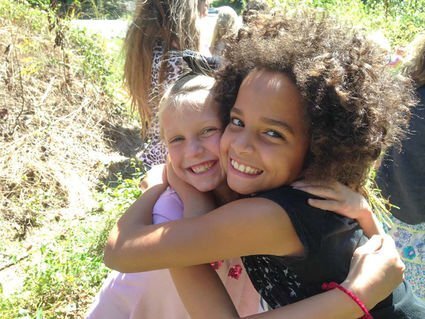Mountain Sun Teaches Art Of Peaceful Resolutions
Two girls share a hug after resolving a conflict.
"I feel sad when you told me that I couldn't play with you because I wanted to play with the blocks too," said a Mountain Sun Community School (MSCS) Owl student.
"I hear that you feel sad because I did not want to play blocks with you, but I feel frustrated because I wanted to play by myself," said another Owl student. "Maybe we can play together after I have five minutes to play alone."
This dialogue is an example of a peace talk, a kind of peaceful resolution that takes place at Mountain Sun Community School. This is one aspect of Montessori philosophy that MSCS incorporates into its unique education.
After these discussions take place, students will hug, shake hands or run off to play. Frequently, students will say things like, "friends," in agreement after they reach a compromise.
The Montessori philosophy was developed by Dr. Maria Montessori, the first female physician in Italy. Mountain Sun Community School integrates many aspects of Montessori philosophy, such as multi-aged classrooms, teachers serving as guides, classroom design and learning materials that encourage use.
The Montessori philosophy recognizes that each classroom should be a beautiful, inviting space that makes all who dwell in it feel safe, welcomed and a part of a larger community. This space becomes sacred for the students, which inevitably creates a sense of accountability for each student and his peers.
The phrase "grace and courtesy" can be heard throughout at MSCS. Teachers remind their students often that the way they act is directly related to the way other students in the classroom learn.
The words "grace" and "courtesy" remind the students that everything they say is a representation of who they are and how they treat other people. They are reminded to use words that make other people, as well as themselves, feel good, safe and welcomed. The practice of using kind words and peaceful confrontation is utilized by both students and teachers.
The Owl and Otter classrooms, pre-k through kindergarten, are introduced to peaceful conflict resolution using concrete measures. There is a peace table which is available to the students for private use as a space to be quiet and find peace or as a place where peace talks may occur.
A peace table is a small table with appropriately sized seating arrangements. Like the classroom standards, the table should encourage respect and peace. The table should have a few key elements: a three-minute timer and an instrument of peace, such as plants, stones, a photo of someone peaceful or other instruments.
The table in the Owl and Otter classroom is set off to the side in order to be observed as a silent and reverent place.
Once the material aspect of the peace table has been established, there is very specific language that is involved. Students are taught, before they are allowed to use the peace table, how to speak with grace and courtesy. They are told that the timer helps them keep in mind that other people may need to use the peace table too and that if you see a student using the peace table, you should let him be until he is finished.
The peace table is also a place that can be used for conflict resolution. In this case, students are taught how to express themselves using "I statements." In the Owl or Otter classroom, it is probable that an elder (meaning an adult or someone who is older than they are) will be called in to help guide the peace talk.
Peace talks are important for the upset student to express his feelings but equally as important for the other student to learn how to listen and see how his actions are affecting his friends and peers. As students move on from the Owl and Otter classrooms, they enter the first through third grade classroom called the Acorn Class."
The person who is hurt confronts the person who hurts them and the person who hurt them repeats what they said," said an Acorn student, articulating a key part of active listening.
In any of the classrooms at MSCS, you cannot refuse a peace talk but you can ask for a break until you feel ready.
Once the students reach their fourth grade year they enter the Monarch class, grades 4-6. This class level is designed for students to have the most freedom. They are given longer work periods, up to three hours, opportunities to volunteer time with the younger classrooms and they attend more field trips and outings.
This freedom is also true when it comes to peace talks. These students have more experience with peace talks and the level of accountability within the classroom is higher."
Unlike the Owls and Otters and Acorns," said a Monarch student, "we don't really have a specific peace table. We don't have many peace talks and when we do we usually have the conversations out in the open."
The Monarchs use an acronym to remind them of how to use peaceful confrontation: VOMP: Voice, Own, Moccasin, Plan."
Mocassins mean empathy, like walk in their shoes," said Brady, a Monarch student. "We learned how to do peace talks before. We don't usually recognize that we are having peace talks anymore. We just start talking," showing that the skills of peaceful confrontation have become ingrained in learning and behavior.
Written by Kayla Leed

